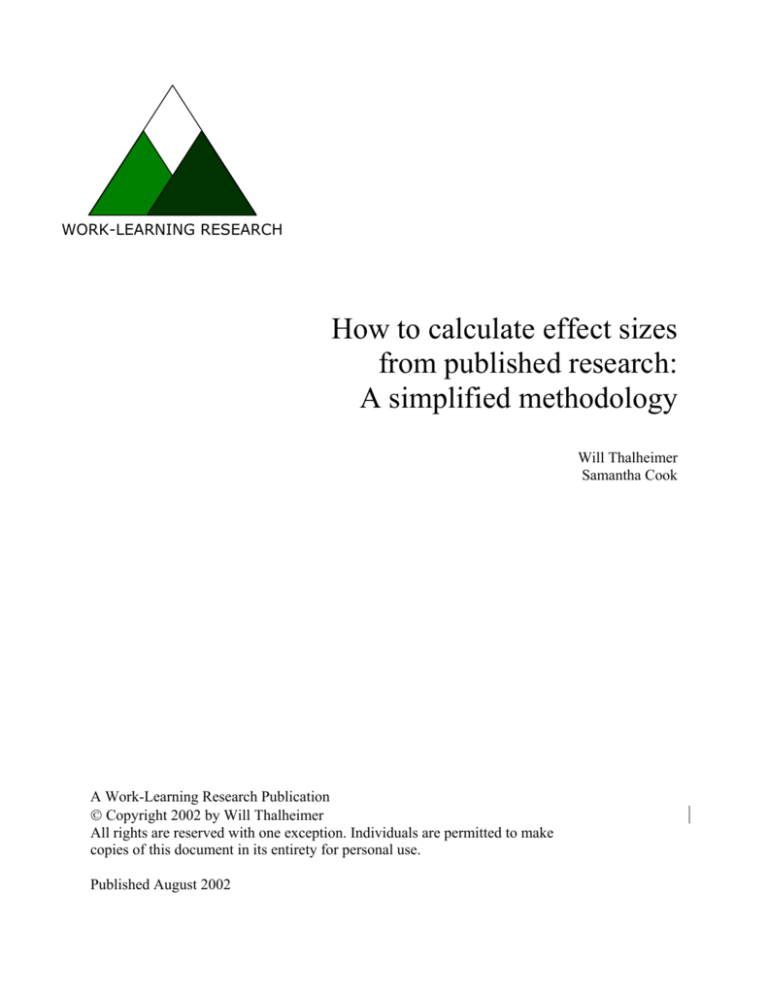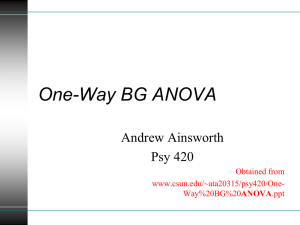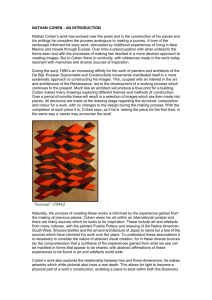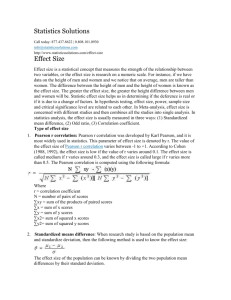
WORK-LEARNING RESEARCH
How to calculate effect sizes
from published research:
A simplified methodology
Will Thalheimer
Samantha Cook
A Work-Learning Research Publication
Copyright 2002 by Will Thalheimer
All rights are reserved with one exception. Individuals are permitted to make
copies of this document in its entirety for personal use.
Published August 2002
Effect Sizes
Work-Learning Research
How to calculate effect sizes
from published research articles:
A simplified methodology
Will Thalheimer
Work-Learning Research
Samantha Cook
Harvard University
Overview
This article provides a simplified methodology for calculating Cohen’s d effect sizes
from published experiments that use t-tests and F-tests. Accompanying this article is a
Microsoft Excel Spreadsheet to speed your calculations. Both the spreadsheet and this
article are available as free downloads at www.work-learning.com/effect_sizes.htm.
Why we use effect sizes
Whereas statistical tests of significance tell us the likelihood that experimental results
differ from chance expectations, effect-size measurements tell us the relative magnitude
of the experimental treatment. They tell us the size of the experimental effect. Effect sizes
are especially important because they allow us to compare the magnitude of experimental
treatments from one experiment to another. Although percent improvements can be used
to compare experimental treatments to control treatments, such calculations are often
difficult to interpret and are almost always impossible to use in fair comparisons across
experimental paradigms.
A simple methodology
Although extensive articles have been written detailing methods for calculating effect
sizes from published research articles (e.g., Rosnow & Rosenthal, 1996; Rosnow,
Rosenthal, & Rubin, 2000), at least some of us—the first author included—require a
simpler approach. This article provides a method to calculate Cohen’s d from both t-tests
and some F-tests of significance. Accompanying this article is a Microsoft Excel
Spreadsheet that can be used to compute Cohen’s d from published data.
Cohen’s d has two advantages over other effect-size measurements. First, its burgeoning
popularity is making it the standard. Thus, its calculation enables immediate comparison
2
www.work-learning.com
Effect Sizes
Work-Learning Research
to increasingly larger numbers of published studies. Second, Cohen’s (1992) suggestion
that effect sizes of .20 are small, .50 are medium, and .80 are large enables us to compare
an experiment’s effect-size results to known benchmarks. The simple methodology
offered below is not new but is drawn from previously published articles, most notably
Rosnow and Rosenthal (1996) and Rosnow, Rosenthal, and Rubin (2000). We have
simplified the methodology not by changing the formulas and calculations but by
discarding as much as possible the jargon and computational rationales typically included
in articles written for research audiences. This article is an attempt to provide a practical
methodology to enable the calculation of effect sizes.
What is an effect size?
In essence, an effect size is the difference between two means (e.g., treatment minus
control) divided by the standard deviation of the two conditions. It is the division by the
standard deviation that enables us to compare effect sizes across experiments. Because ttests and F-tests utilize different measures of standard deviation, two separate
calculations are required. You will find it useful to keep this distinction in mind as you
read this document and utilize the accompanying spreadsheet.
Table of Contents
Calculating Cohen’s d from t-tests
Page 4
Calculating Cohen’s d from t-tests:
When you don’t have standard deviations or standard errors
Page 5
Calculating Cohen’s d from t-tests:
When you have standard errors instead of standard deviations
Page 6
Calculating Cohen’s d from F-tests:
Page 7
Calculating Cohen’s d from F-tests:
When you don’t have MSE’s
Page 8
References
Page 9
How to cite this article
Page 9
Acknowledgements
Page 9
3
www.work-learning.com
Effect Sizes
Work-Learning Research
Calculating Cohen’s d from t-tests
(1)
d = xst − xc
pooled
Key to symbols:
d = Cohen’s d effect size
x = mean (average of treatment or comparison conditions)
s = standard deviation
Subscripts: t refers to the treatment condition and c refers to the
comparison condition (or control condition).
How to calculate:
The article should list the means ( x ) of the treatment condition
and the comparison condition. Use those numbers in the formula
and calculate the pooled standard deviation by using Formula 1a
below. After you use Formula 1a, simply finish calculating
Formula 1 to get Cohen’s d.
(nt −1)st + (nc −1)sc
nt + nc
2
(1a)
s pooled =
2
Key to symbols:
s = standard deviation
n = number of subjects
Subscripts: t refers to the treatment condition and c refers to the
comparison condition (or control condition).
How to calculate:
The article should list the number of subjects (n) and the standard
deviations (s) of the treatment condition and the comparison
condition. Use those numbers to make your calculations. If the
article does not list the standard deviations, use either Formula 2 or
Formula 3 below if possible.
4
www.work-learning.com
Effect Sizes
Work-Learning Research
Calculating Cohen’s d from t-tests:
When you don’t have standard deviations or standard errors.
When an experiment that uses a t-test does not list standard deviations, you can
calculate Cohen’s d as follows using the t statistic:
(2)
nt + nc nt + nc
d = t
nt nc nt + nc − 2
Key to symbols:
d = Cohen’s d effect size
t = t statistic
n = number of subjects
Subscripts: t refers to the treatment condition and c refers to the
comparison condition (or control condition).
How to calculate:
The article should list the t statistic, which it will usually do, for
example, with the following notation: t (29) = 3.12, where 29 is the
degrees of freedom and 3.12 is the t statistic. The article should
also list the number of subjects (n) within each condition. Use
those numbers to make your calculations. If the article does not list
the number of subjects in each condition but does list the total
number of subjects—and if you can assume that both conditions
have roughly equal numbers of subjects—you can estimate
Cohen’s d by using Formula 2a below.
Warning: Some studies using repeated-measure designs (where
each subject is measured several times within the same condition)
incorrectly use experimental trials, instead of subjects, as the units
of analysis. The formulas on this page cannot be used for these
studies because the t-statistic is not relevant to the number of
subjects (n) in the study. These studies are often easy to spot
because they have outrageously high degrees of freedom.
(2a)
d≈
2t
n−2
5
www.work-learning.com
Effect Sizes
Work-Learning Research
Calculating Cohen’s d from t-tests:
When you have standard errors instead of standard deviations.
When an experiment that uses a t-test does not list standard deviations but does
list standard errors (SE), you can calculate the standard deviations as follows and
then use the resulting numbers in Formula 1a:
(3)
s = SE n
Key to symbols:
s = standard deviation
SE = standard error
n = number of subjects
How to calculate:
This formula assumes that the article lists the standard error (SE)
and number of subjects (n) within each condition. Use those
numbers to make your calculations.
6
www.work-learning.com
Effect Sizes
Work-Learning Research
Calculating Cohen’s d from F-tests
(4)
d=
xt − xc
nt + nc − 2
MSE
nt + nc
Key to symbols:
d = Cohen’s d effect size
x = mean (average of treatment or comparison condition)
n = number of subjects
MSE = mean squared error
Subscripts: t refers to the treatment condition and c refers to the
comparison condition (or control condition).
How to calculate:
If standard deviations are available, use Formulas 1 and 1a above
because MSE’s will not produce a precise Cohen’s d when the Ftest is a comparison among more than two conditions. Otherwise,
continue.
The article should list the means ( x ) of the treatment condition
and the comparison condition, and the mean squared error (MSE).
Use those numbers in the formula to get Cohen’s d. Be careful to
select the correct MSE if many are listed. Note that only when the
F-test numerator degrees of freedom are equal to 1—when the Ftest compares one condition to one other condition—will the MSE
produce an exact Cohen’s d effect size. In this case, the F-test is
equivalent to a t-test. Selecting other MSE’s may not produce valid
results.
7
www.work-learning.com
Effect Sizes
Work-Learning Research
Calculating Cohen’s d from F-tests:
When you don’t have MSE’s.
When an experiment that uses an F-test does not list the MSE, you can calculate
Cohen’s d as follows using the F statistic. This calculation should only be used
when the F-test compares one condition to one other condition.
(5)
d=
nt + nc nt + nc
F
nt nc nt + nc − 2
Key to symbols:
d = Cohen’s d effect size
F = F statistic
n = number of subjects
Subscripts: t refers to the treatment condition and c refers to the
comparison condition (or control condition).
How to calculate:
This formula can ONLY be used when the F-test compares two
conditions (when the first degrees of freedom is equal to one). The
article should list the F statistic, which it will usually do, for
example, with the following notation: F (1,39) = 3.12, where 1 is
the degrees of freedom based on the number of conditions, and 39
is the degrees of freedom based on the number of subjects. The
article should also list the number of subjects (n) within each
condition.
8
www.work-learning.com
Effect Sizes
Work-Learning Research
References
Cohen, J. (1992). A power primer. Psychological Bulletin, 112, 155-159.
Rosnow, R. L., & Rosenthal, R. (1996). Computing contrasts, effect sizes, and
counternulls on other people’s published data: General procedures for research
consumers. Psychological Methods, 1, 331-340.
Rosnow, R. L., Rosenthal, R., & Rubin, D. B. (2000). Contrasts and correlations in
effect-size estimation. Psychological Science, 11, 446-453.
How to cite this article
Thalheimer, W., & Cook, S. (2002, August). How to calculate effect sizes from published
research articles: A simplified methodology. Retrieved November 31, 2002 from
http://work-learning.com/effect_sizes.htm.
(NOTE: You should replace the fictional November 31 date with the date on which the
article was downloaded.)
Acknowledgements
We would like to thank Allison Stieber for copyediting this document and Don Rubin for
supporting the second author’s involvement in this effort.
9
www.work-learning.com







